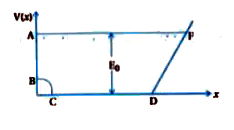In an elastic collision of two billiard balls,which of the the following quantities remain conserved during the short time of collision of the balls ? (i.e. when they are in contact)
(a) Kinetic energy.
(b) Total linear momentum.
Give reason for your answer in each case.Solution in Gujrati
There may be increase in PE while balls are in contact, this decreases KE. Hence, KE is not conserved. Here, resultant external force is zero, hence the total linear momentum is conserved.
Topper's Solved these Questions
- WORK, ENERGY AND POWER Book:KUMAR PRAKASHANChapter:WORK, ENERGY AND POWER Exercise:SECTION - D NCERT Exemplar Solutions (Short Answer Type Questions)
Explore 10 Videos
- WORK, ENERGY AND POWER Book:KUMAR PRAKASHANChapter:WORK, ENERGY AND POWER Exercise:SECTION - D NCERT Exemplar Solutions (Long Answer Type Questions)
Explore 5 Videos
- WORK, ENERGY AND POWER Book:KUMAR PRAKASHANChapter:WORK, ENERGY AND POWER Exercise:SECTION - D NCERT Exemplar Solutions (Multiple Choice Questions)
Explore 21 Videos
- WAVESBook:KUMAR PRAKASHANChapter:WAVESExercise:SECTION-F (Questions From Module) (Sample questions for preparation of competitive exams)
Explore 23 Videos
Similar Questions
A graph of potential energy V(x) verses x is shown in figure .A particle of energy E0 is executing motion in it . Draw graph of velocity and kinetic energy verses x for one complete cycle AFA.

View SolutionA block of mass 1 kg is pushed up a surface inclined to horizontal at an angle of 30∘ by a force of 10 N parallel to the inclined surface (figure) . The coefficient of friction between block and the incline is 0.1 .If the block is pushed up by 10 m along teh inclined calculate

(a) work done against gravity
(b) work done against force of friction
(c ) increases in potential energy
(d) increases in kinetic energy
(e) work done by applied force
View SolutionAn electron and a proton are moving under the influence of mutual forces . In calculating the change in the kinetic energy of the system during motion , one ignores the magnetic force of one on another . This is , because
View SolutionIn a standing wave formed by two atoms separated by 1.21Å, there are 3 nodes and 2 antinodes. Find its wavelength.
View SolutionAnwer carefully, with reasons:
a) In an elastic collision of two billiard balls, is the total kinetic energy conserved during the short time of collision of the balls (i.e. when they are in contact)?
Is the total linear momentum conserved during the short time of an elastic collision of two balls?
c) What are the answers to a) and b) for an inelastic collision?
d) If the potenital energy of two billiard balls depends only on the separation distance between their centers, is the collision elastic or inelastic? (note we are talking here of potential energy corresponding to the force during collision, not gravitational potential energy).
View SolutionIn an elastic collision of two billiard balls, which of the following quantities remain conserved during the short time of collision of the balls (i.e., when they are in contact).
(a) Kinetic energy . (b) Total linear momentum ?
Give reason for your answer in each case.
View SolutionIn an elastic collision of two billiard balls, is the total kinetic energy conserved during the short time of collision of the ball (i.e when they are in contact)?
View SolutionIn an elastic collision of two billiard balls which of the following quantities is not conserved during the short time of collision :
View SolutionAnwer carefully, with reasons: a) In an elastic collision of two billiard balls, is the total kinetic energy conserved during the short time of collision of the balls (i.e. when they are in contact)? Is the total linear momentum conserved during the short time of an elastic collision of two balls? c) What are the answers to a) and b) for an inelastic collision? d) If the potenital energy of two billiard balls depends only on the separation distance between their centers, is the collision elastic or inelastic? (note we are talking here of potential energy corresponding to the force during collision, not gravitational potential energy).
View SolutionAssertion : In an elastic collision of two billiard balls, the total knetic energy is conserved during the short time of oscillation of the balls ( i.e. when they are in contact ) .
Reason : Energy spent against friction does not follow the law of conservation of energy .
View SolutionAnswer with reason: In an elastic collision of two billiard balls, is the total kinetic energy conserved during the short time of collision of the balls (i.e., when they are in contact )?
View SolutionAnswer carefully, with reasons : In an elastic collision of two billiard balls, is the total kinetic energy conserved during the short time of collision of the balls (i.e. when they are in contact)?
View SolutionAnswer carefully, with reasons : Is the total linear momentum conserved during the short time of an elastic collision of two balls?
View SolutionAnwer carefully, with reasons:
a) In an elastic collision of two billiard balls, is the total kinetic energy conserved during the short time of collision of the balls (i.e. when they are in contact)?
Is the total linear momentum conserved during the short time of an elastic collision of two balls?
c) What are the answers to a) and b) for an inelastic collision?
d) If the potenital energy of two billiard balls depends only on the separation distance between their centers, is the collision elastic or inelastic? (note we are talking here of potential energy corresponding to the force during collision, not gravitational potential energy).
View SolutionIn an elastic collision of two billiard balls, which of the following quantities remain conserved during the short time of collision of the balls (i.e., when they are in contact).
(a) Kinetic energy . (b) Total linear momentum ?
Give reason for your answer in each case.
View Solution